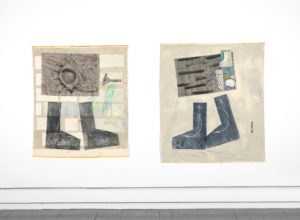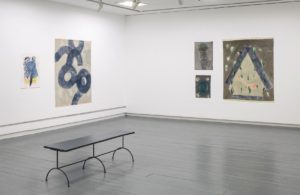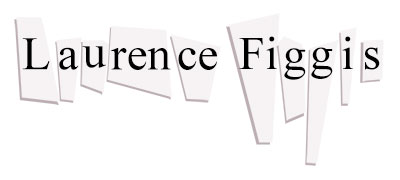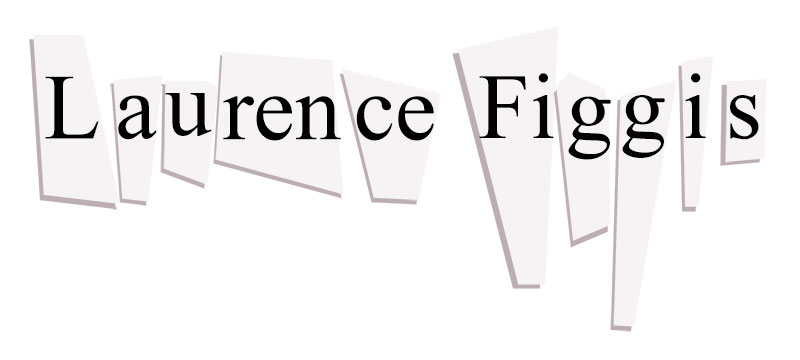Paintings with Legs
‘and the world is a white laundry,
where we are boiled and wrung
and dried and ironed,
and smoothed down’(1)
Inger Christensen
When I visit Lotte in her studio, and I look at one of her paintings, I see legs. These L-shapes have been made from cut-wood shapes smeared with ink, pressed against the calico to leave a mark (a sort of wood-cut, a sort of mono-printing). And all I can see is legs. But that seems like a heavy cumbersome word—“legs”—too cumbersome—and I keep the word to myself, until the artist says it—legs.

‘Lotte Gertz: Migrating Eye’, 2019 (installation view) ©Lotte Gertz
She reminds me that, a while ago, she left the city to spend time making work in a rural place—much of her new work was made there. She has done it a few times: collapsed her studio down, and taken it away, and set it up again, in a new place. I think of an artist in transit—carrying their tools and materials and the works they are making. I think of these works and tools as a kind of language.
I think of Gulliver, on his travels; how in the fictional metropolis, Lagado, he found the most educated citizens practicing an unusual form of speech. Fearing that spoken language would be corrosive to the lungs and contribute to the shortening of lives, they proposed ‘a scheme for entirely abolishing all words whatsoever,’ and since words are ‘only names for things’ found it preferable to carry about them such things as were necessary to express their business. As Gulliver remarks: ‘I have often beheld two of those sages almost sinking under the weight of their packs, like pedlars among us; who, when they meet in the streets would lay down their loads, open their sacks, and hold conversation for an hour together’(2).
Lotte draws my attention to one of the paintings—a house that looks like language or vice-versa. I have heard it said that ‘houses are really bodies’; that ‘we connect ourselves with walls, roofs, and objects, just as we hang on to our livers, skeletons, flesh and bloodstream’(3). But are houses ever like the words spoken by these fleshy, skeletoned, en-livered, sanguine things?
Do images shelter inside words? Do they watch fearfully from the edges of ciphers—is the gap in the letter “A” a window in the house; is the head of the image pressed against the window and staring out?
The artist tells me that, when she was making work in the country, she overheard her child and some other children pretending to “sink” Trump in a pond, with some other notorious men, names familiar to us, heavy, ominous names for the parents listening to the children play. The children’s voices made the words seem lighter.
I imagine their voices dulled, softly muted, wrapped in cotton wool; like children’s voices heard on a summer day by someone drifting off to sleep. I think of Lotte making her paintings while half-listening to the children play; cutting bits out, sticking bits on top, letting the paint-marks that cannot be erased lie beneath other paint-marks, building space.
As I look at the paintings, the shapes that look like broken bits of language turn again into legs, as they might be glimpsed—silhouette-like— against bright light, two sticks flattened for a moment against the light. Above the legs a skirt; but the image has been cut off in such a way that the skirt becomes a rectangle—and this suggests a box floating above the legs (perhaps because a skirt is, in some respects, a kind of box made of fluid collapsible material).
I am afraid to say: “that looks like a pair of legs coming out of a box”. I say “abstract”. And the artist, smiling, says that she does not think of the work as abstract. And she is right—I was afraid of seeming foolish by saying what I really saw: the lower half of a person walking around in a skirt shaped like a box (or a skirt shaped like a house made of language).
And so I say the word “abstract”—which is the perfect word to silence these perceptual fumblings. And the word “abstract” falls out of my mouth and rolls around on the floor: a perfectly hollow, a perfectly useless, shiningly plastic thing. And having spat that word out, I am relieved to be rid of it. I look at my “abstract” lying there on the studio floor, shining, covered in my spit.
Soon the artist will make another journey. She will take her paintings out of the place-for-making (which sometimes looks like a house made of language) and collapse them down, and take them to a place-for-looking, and open them out again.
Lotte’s paintings can be folded and wrapped-around, they can be draped, they can be crushed in the hand. But she does not want them to be folded, wrapped-around, or draped, or crushed.

‘Lotte Gertz: Migrating Eye’, 2019 (installation view) ©Lotte Gertz
She wants them to be seen as flat, as measured, and at the same time as soft, as the quietly-eroding fresco-walls of ancient times.
But after being folded up and carried they will likely crease. And so she will take her iron and her ironing board, and she will iron all the paintings carefully until all the creases are gone; until they can be seen as she wants them to be seen; until the person who does the looking is able to see exactly what she wants them to see. And then, with some care (so as not to crease them again), she will lift up the paintings, and—perhaps with the help of another person—carry them across the room, and attach them to the wall.
And then we will be able to look at them.
Laurence Figgis, February 2019
1 Inger Christensen, ‘From Letter in April: VI’, 2009
2 Jonathan Swift, Gulliver’s Travels, 1726
3 Leonora Carrington, The Hearing Trumpet, 1960
This text was commissioned for the exhibition, ‘Lotte Gertz: Migrating Eye,’ Intermedia / CCA, Glasgow (28thFebruary – 9thMarch 2019)

